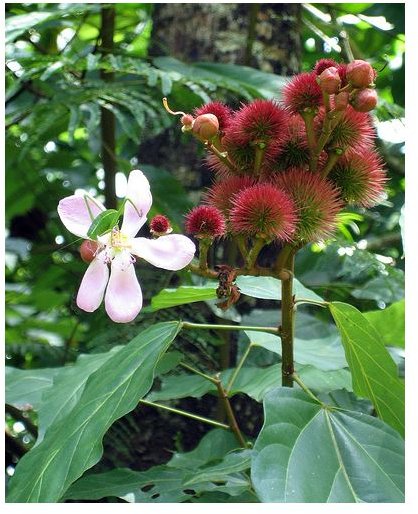What is Annatto and How is it Beneficial for Healing?
Natural Food Coloring or Natural Medicine?
Annatto, or Bixa orellana, is a rainforest herb that has a range of healing benefits from protecting the liver to treating indigestion. What is annatto when it is listed as an ingredient on packaged food? Annatto is also a yellow-orange pigment used to color food. This plant is very well-known for its pigment and has in fact been a coloring agent in Central and South America for hundreds of years. From dying fabric, to food, to being made into a paint these little seeds have had much to offer indigenous tribes.The seeds are used for their color but they also contain beneficial compounds, including salicylic acid, ellagic acid, and beta-carotene, which make annatto a healing herb. The leaves and roots are also used in traditional medicine.
Traditional Uses
Perhaps because this plant is famous for its bright color it has not been given as much attention as a source of medicine in the West. Because of this there is not sufficient evidence or research to support the uses of annatto. Studies have been done instead to test for its safety as a natural food coloring. There are however many traditional benefits of this plant.
Annatto is known to have diuretic, anti-inflammatory, anti-bacterial, astringent, and expectorant properties. It is rich in antioxidants including beta-carotene, which help to protect cells from free radical damage. With anti-bacterial properties it can be used to destroy harmful microbes. It is believed to protect both the liver and kidneys, which as a diuretic annatto does have the benefit of removing waste from the urinary system, thus relieving the work of these organs of elimination.
This herb is also used traditionally for digestive problems, including diarrhea, heartburn and upset stomach. In Peru the dried leaves, known as achiotec, are infused into a tea to treat a range of conditions including digestive problems, prostate disorders, high cholesterol, obesity, and to support the liver and benefit the skin.
The seeds of the annatto plant are known to have expectorant properties, making them useful for the common cold and bronchial problems. Annatto can be used for reducing inflammation, helping to expel mucus, and suppressing coughs.
This plant also appears to raise blood sugar levels, making it a possible natural treatment for diabetes. At the same time with insufficient research people who have diabetes should be careful when using annatto as a medicinal aid as it can affect blood sugar.
How to Use Safely
To make a tea from the leaves, which is primarily used for digestive issues, prostate problems, liver support, and skin problems, infuse one quart of fresh boiled water with 8 to 10 leaves. This infusion can be drunk warm or cold, one to three cups daily. Annatto seed powder can be found in capsule form. Another way to enjoy the benefits of annatto is to cook with the seeds. They add a mild, peppery flavor and plenty of bright color to food.
While there are not known negative side effects of this popular rainforest herb, talk to your doctor before use if you are pregnant, nursing, on any prescription medication, or if you have diabetes.
What is annatto — a natural food coloring found in countless commercial products or a medicinal herb that has been used for centuries to support well-being? It is clearly both, and it certainly is a widely appreciated plant in many forms.
References
Achiote herb (Ray Sahelian, MD) https://www.raysahelian.com/achiote.html
Bixa orellana <www.fs.fed.us/global/iitf/pdf/shrubs/Bixa%20orellana.pdf>
Balch, Phyllis A. “Prescription for Nutritional Healing.” Fourth Edition (Penguin Books, 2006).
Raintree Nutrition https://www.rain-tree.com/annato.htm
photo by Jose Oquendo (CC/flickr) https://www.flickr.com/photos/oquendo/1449251963/
Disclaimer
Please read this disclaimer regarding the information contained within this article.
